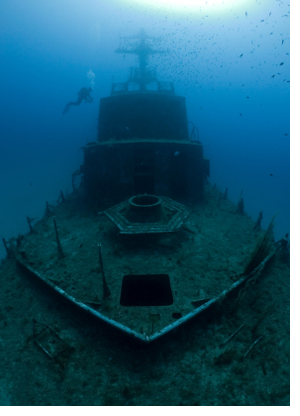 It’s been all over the news: the Titanic exploration team has been spending the past few weeks off the Maritime coast, exploring the wreckage of the legendary steamer. Their latest offering is an eerie 3-D video of the sunken ship. But the Titanic was not the only legend lost in or near Canadian waters. This week’s links explore the stories and pictures of these shipwrecks.
It’s been all over the news: the Titanic exploration team has been spending the past few weeks off the Maritime coast, exploring the wreckage of the legendary steamer. Their latest offering is an eerie 3-D video of the sunken ship. But the Titanic was not the only legend lost in or near Canadian waters. This week’s links explore the stories and pictures of these shipwrecks.
Just two years after the Titanic‘s sinking, another liner went down?this time in the St. Lawrence River. The story of the Empress of Ireland is perhaps even more tragic than that of its more famous predecessor. Accidentally rammed by a Norwegian ship during a thick spring fog, the Empress sank in just 14 minutes; although there were plenty of lifeboats, there wasn’t enough time to launch them. Nearly 70 per cent of those on board perished, including more passengers than lost their lives on the Titanic. This PBS special tells the tale, and describes exploration attempts.
The 1917 accidental collision between a munitions ship and relief ship in Halifax Harbour didn’t sink the vessels, but the consequences were far worse. The munitions ship caught fire, leading to a devastating explosion, tsunami, and pressure wave that destroyed parts of Halifax and Dartmouth and killed 1,700 (including many bystanders who had gathered to watch the spectacle). This illustrated piece, from the Maritime Museum of the Atlantic, tells the shocking story.
Shipwrecks weren’t limited to the East; in fact, Vancouver Island has been referred to as the Graveyard of the Pacific, with at least one ?wrecked ship for every mile of coast.? This site, maintained by the Maritime Museum of B.C., explains why, and offers stories, maps, photos, and an interactive game.
One wreck That’s to this day enveloped in mystery is the Edmund Fitzgerald, an ore freighter that disappeared during a storm in Lake Superior in 1975. Because all 30 men on board perished, and the stormy conditions and poor radio communications prevented other boats in the area from witnessing the incident, no one knows exactly why or how it happened. This article discusses some of the theories.

